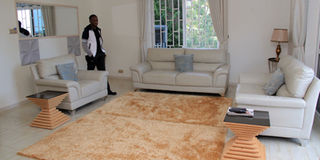Arranging furniture in your living room

Ensure your furniture is not placed against the wall. Also, place stools next to chairs. PHOTO | RACHEL MABALA
What you need to know:
Here is how to arrange your furniture with an interior designer’s eye.
The proper arrangement of furniture can make the room look brighter, larger and efficient. It will also set the tone of how you live in it.
However, this task is daunting, more so when you are working with a clean palette. That is because to ensure that you organise the pieces in an aesthetically pleasing yet practical manner is no walk in the park. Here are a few tips.
Know your room measurements
It is important to know the size of the room in order to know the most suitable location of the furniture.
“Measuring the room also helps you know the ideal size of the furniture you need. That way, you will avoid having ill fitting pieces or having to return the furniture to the store as this is not only time wasting, but also cumbersome and costly in regards to transportation. If you want to make customised furniture, measurements are a must,” Adrian Wangwe, an interior designer with Moonic, shares.
Natural focal point of the space
Your focal point could be architectural, say a fire place, or a window. “However, you may also create one, such as using a TV set. With that in mind, ensure that you place your seating around it,” Wangwe says.
No chairs in front of doorways
Placing a chair or sofa in front of the doorway limits movement space seeing that people will be coming in and going through it. “It also distorts pathways,” Wangwe shares.
However, Edmund Ssesanga, an interior designer, says the exception comes in where the doorway is wide enough to carry a chair and yet have enough room for people to pass.
“The chair one can place should be one bearing a message, picture or is stylish such as a pouf. Such a chair is meant to draw the attention of people and what better place to put it than in the doorway,” he says.
Ssesanga adds that it is also important to note that the doorways should not be many.
“Two is good enough with one coming from the balcony and another leading to the kitchen. An open flow is ideal because the living room is a public space thus congestion should be minimised.”
Place a table near each chair
The table serves two functions; decor and a place for people to utilise. “Therefore, close proximity to the chairs is ideal as it also creates a way to bring people together for easier conversation,” Wangwe says.
Group chairs
This could be three to four feet apart. “This allows each person to have individual space yet be able to converse with others easily,” he adds.
No furniture by the wall
Apart from spoiling the wall with time owing to movement, Doris Nyange, an interior designer, says furniture close to the walls makes the room look smaller and prohibits walking space because with people occupying chairs on both sides, it is unbecoming to walk in between them.
“More to that, with furniture gracing the walls, an empty centre is left, as such, holding any form of conversation almost impossible as the people are far from each other.”
Identify traffic patterns
When organising your furniture, rather than block paths, use these pieces to create or demarcate paths.
“In an open layout where there is a flow from one space to another, furniture will work well for path creation. So you may push the furniture near a doorway to show where people can pass. Apart from using chairs and sofas, rugs may also do the job as they lead the eye on where to go,” Nyange adds.
Mix furnishings for variation
Furnishings of various sizes and texture add visual interest to the room.
“However, it is important to add some balance but do not go crazy with it. For example, if you have a rectangular sofa, a round table will compliment it. However, do not group small items alone while bigger ones are in another batch,” Wangwe explains.
You may also use scaled pieces to create balance as they are more serene when used together to create a harmonious environment. “However, when they are out of scale, they create an uncomfortable feel,” he adds.
Decor placement
Paintings and other wall decorations placed high can help make the space look larger.
“Besides that, strategically placed mirrors can also achieve the same effect by reflecting light,” Nyange shares.
Use an artist’s perspective
You need to look at your space as a painter looks at a canvas. One of the aspects you can employ in organising your furniture is triangulation.
“In this aspect, the seat must be near the wall, the painting near the seat must have a rhythm. For example, it could be of nature so that it speaks about your love for the outdoors or conservation. In addition, the size of the living room must be minimally three feet by three feet and the number of seats should not be many - two three-seater sofas with a table in between and a picture above either chair is the ideal setting,” Ssesanga says.




